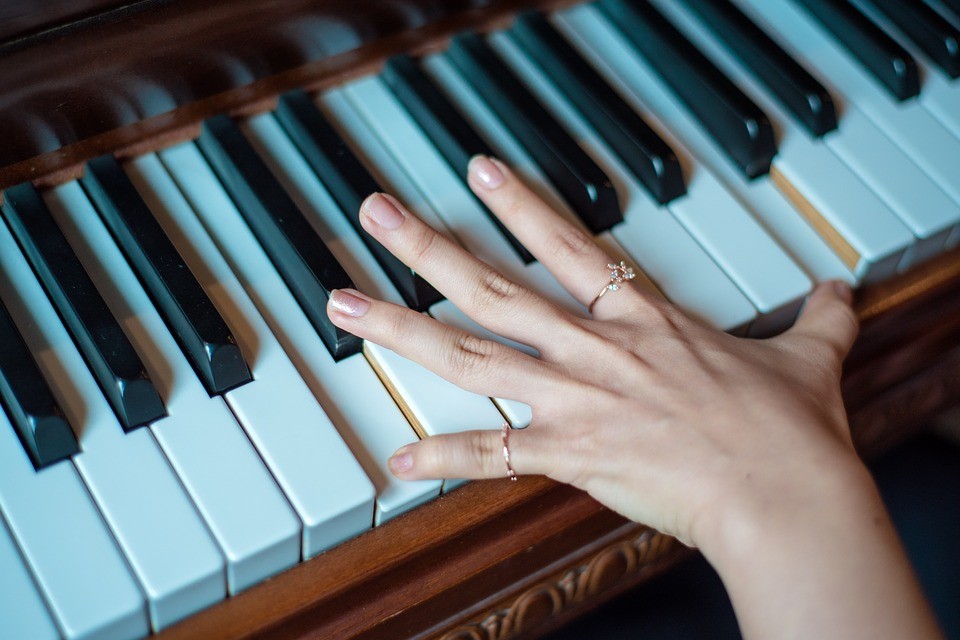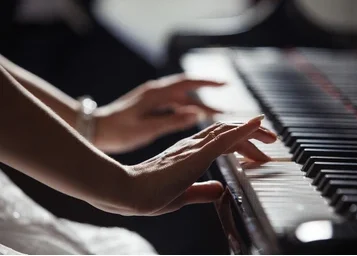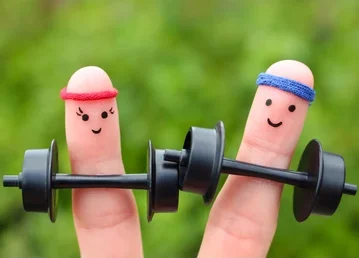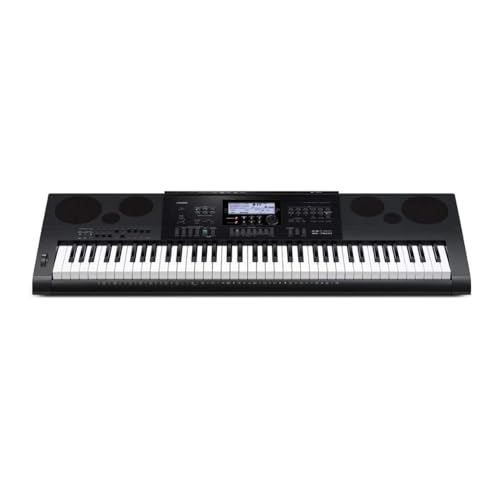Proper finger positioning plays a significant role in the prevention of injuries and improving technique. Finger exercises are a must for piano players to improve their playing skills. You might have seen babies and other people of youth yearning to play the piano. Their experience can only grow more with proper hand exercises for piano to strengthen their fingers and make it flexible. Here we are going to teach you some of the best and most effective Finger Stretching Exercises.
Also Read:- How to Improve Piano Skills Without a Teacher?
Table of Contents
- Top 11 Finger Stretching Exercises for Piano Players
- 1. 5 Note Pentascales At A Time
- 2. Combination Of Ascending And Descending Pentascales
- 3. Arms Out, Palms Up
- 4. Go Swimming
- 5. Extend Arm Forward As You Pull Back On your Fingertips
- 6. Play With Firm Finger Position
- 7. Rock Climbing
- 8. Over-Legato
- 9. Use One Hand To Play Two Notes At The Same Time
- 10. Finger Lifts
- 11. Finger Stretches
- For How Long Should These Stretches Be Done?
- How To Figure Out If The Stretches Are Effective.
- Activities To Avoid That Makes You Stiff
- External Care For Fingers
- Our Recommendation
- Frequently Asked Questions (FAQs)
Top 11 Finger Stretching Exercises for Piano Players

Below are some of the top finger stretching exercises that are necessary for any piano player:
1. 5 Note Pentascales At A Time
This is a finger stretching exercise where the piano player uses five notes with the help of a single finger. Using one finger on different tones helps improve and come up with the best experience. Here, you play as you listen to check whether the result is better than before. The more you exercise, the more you become used to playing with finger muscles. With no hand exercise, you will always play with whole arms or even shoulders. Although it is a simple task, players with weak muscles make it difficult.
2. Combination Of Ascending And Descending Pentascales
After mastering the five-note pentacles exercise, it is advisable to play an ascending and descending pentacles exercise. This is where you play from the lowest to the highest finger. Playing with both piano’s small hands is crucial as there will be a combination of efforts. The left-hand pinky is said to play better with the right-hand thumb. Carefully observe the proper finger technique to make a perfect combination with the song.
3. Arms Out, Palms Up
Put your arms out in a parallel manner to your sides and then slowly pull your fingers down towards the ground. Immediately, there will be a certain feeling in your muscles that surround the elbow. In case you do not feel it, slowly lift your arms and stretch your fingers downwards. You may look funny to the person watching you since they feel you are doing nothing. This is one of the best finger stretch exercises for piano players.
4. Go Swimming
You may wonder how this exercise is of help to a pianist, but it is one of the most useful finger stretches and hand stretches. Just let your legs float as you mainly swim with your arms. This will stretch your arms making your fingers stronger which works miracles especially when you play the piano immediately after swimming. Typically, swimming stretches nearly all upper-body muscles which favors the pianist.
5. Extend Arm Forward As You Pull Back On your Fingertips
This is a very simple finger workout but very recommendable for pianists. Stretch your arm in front of your entire body with your palms down. Using the other hand, firmly grab the fingers of the extended hand and at a slow pace stretch them in an upper motion. This promotes the flexibility of the forearm beneath the wrist on the palm side. Repeat this with both hands for at least three times before and after playing piano. This exercise is close to the “Arms Out Palms Up” but the difference is that these workouts target different arm muscles.
6. Play With Firm Finger Position
Strengthen your fingers to ensure the fingers firmly hold onto the piano. Players with weak piano small hands find it very difficult to have good sound combinations. This will always push the player to play off-key, especially during singing. For the best results, it is essential to ensure your fingers are firm and strong. This is an exercise that is very simple for any player though some people face difficulties. This calls for exercise for better experiences. Lifting your hand while maintaining your finger position, let your fingers fall onto the key. If the fingers fall out of place, repeat this at a lower height.
7. Rock Climbing
This is a workout that is fruitful in building strong hands as well as fingers. Players who consistently climb rocks have incredibly attained strong fingers that favor piano playing. Rock climbing leaves your hand and fingers tight even after the workout. This has been the main secret behind the success of some great composers like Brahms. This workout is only recommended for at most twice a week. Overdoing this finger stretch exercise will only become counter-productive resulting in tight and fatigued hand muscles and forearm.
8. Over-Legato
This is a finger exercise where you play various notes in a way that every note overlaps with the subsequent one. For instance, when playing the C major pentacles, hold down your thumb up to the moment you will play using your index finger. Then this is the best time to lift your thumb and keep playing with the middle finger. This exercise is beneficial for developing awareness of your fingers. It is also essential in learning to control each finger at a time.
9. Use One Hand To Play Two Notes At The Same Time
Naturally, the right-hand thumb plays simultaneously with the middle finger as the other fingers relax. The little finger will occasionally want to take part in playing even when it is not necessary. Proper timing will discipline the fingers making you a great pianist without much strain.
10. Finger Lifts
For great sounds, finger lifts work better as they help exercise your fingers as they move around the keyboard. For every pianist, finger lifts are critical as they boost your playing experience and skills. Lift your ring finger high enough to depress the keys before you start playing properly.
11. Finger Stretches
Obviously, stretching your fingers before even laying them on the piano will help warm up your finger muscles. Just as the body rests, the fingers also become stiff especially if there is no warm-up. The first step is to close your fingers into tight fists for some seconds and then release them. Repeat this severally alongside bending each finger individually to foster better finger independence.
There are also many pianos which are smaller in size which might be easier for people playing piano with small hands. These smaller pianos might help people with smaller finger. These piano for small hands are listed below.

For How Long Should These Stretches Be Done?
If you play the piano professionally and frequently, or even if you are just learning, you should practice finger stretches on a daily basis to enhance your performance and prevent injuries from overusing the piano instrument. Despite the fact that the piano is a stunning instrument, playing it well requires a great deal of physical and mental work from the artist. Long practice sessions and performances can wear you out and put you at risk for a variety of ailments and injuries. However, if you regularly engage in a few key stretches and hand exercises for pianists, you’ll discover that it helps to develop your strength as a pianist.
How To Figure Out If The Stretches Are Effective.
By increasing blood flow to your hands, stretching fingers helps to warm the muscles and ligaments and give them the oxygen and nutrients they require to continue working. By progressively lengthening muscles, it also lowers the risk of damage. But there’s no need to extend excessively. Most of the time, you may feel a tiny tug on the muscle when you are stretching appropriately. Even while stretching properly might not feel completely comfortable, you should exert a little pressure to eventually become more flexible. If your fingers begin to hurt sharply or stabbing, you are extending your muscles beyond their range of motion. You are risking harming yourself by overstretching.
Activities To Avoid That Makes You Stiff
Avoid tense shoulder, wrist, and hand postures. Your wrists and elbows should be roughly in line, you should be at ease, and your feet should easily contact the ground. Your feet should also be relaxed. Never bend the tips of your fingers outward and watch out for very flat hands. Always try to play and work out musically rather than mechanically. Even exercises should sound melodic, and trying to identify the chords and scales you are employing is a wonderful practice activity. Be mindful of dynamics and loudness. Being conscious of the “forte”s and “piano”s of the music you’re playing may alter everything, yet playing at extremely high levels (particularly if you play a digital instrument) might harm your hearing. Avoid fingering, especially during challenging portions. You’re probably doing things incorrectly if you’re performing strange leaps or have no fingers left after a run. Employ a metronome. It is a big assistance but I can also be able to play without it! Do not grow your nails too long, trim them on a regular basis.

External Care For Fingers
- One of the easiest warm-ups for pianists is also one that is quite clear yet sometimes disregarded. If at all feasible, run warm water over your hands or submerge them in a basin or sink of warm water. The water must be warm, not hot, and this cannot be stressed enough! Scalded hands are awkward to move. At the same time, avoid letting your hands soak in warm water for too long or the water will cool. The lumps at the ends of your arms that are cold hands are rigid and immobile. Even when you play, you might want to wear fingerless gloves if your hands are often cold.
- It may be quite difficult to perform and to prepare for a performance. Some of the mental tricks people engage in—mostly those involving anxiety and fear—can be translated into rigidity in the muscles, making it difficult to move freely over the keys. However, it might be really challenging to relax! Simply “trying to relax” might lead to increased tension and tense muscles. It’s crucial to take a moment to remind yourself what it feels like to have relaxed muscles. Controlling dynamics, staccato strokes, and even bigger jumps across the keyboard requires the ability to relax.
- Put your hands palms down on a table or other flat surface. Pull your fingers up into the traditional piano hand posture while keeping the wrist flat on the ground (fingertips and the side of the thumbnail touching the table). After pausing, let the fingers return to their flat posture. Repeat this several times.
- Stop with the fingers curled after repeatedly moving them up and down. Lift the thumb and each finger one at a time off the table as high as you are comfortable doing so. You shouldn’t try to push the fourth finger of either hand to rise higher than the others because it won’t.
- The fingers should start off curled. Lift each finger both sequentially (1-2-3-4-5) and randomly (for example, 1-3-2-5-4).
- Lift the hands off the flat surface and hold them in front of you with the palms facing down. Gently straighten and split the fingers, then make a loose fist with them. Perform the hand exercise many times, then flip your hands over so that your palms are facing up.
- Hold the hands with the palms facing you and the fingers pointing up. Touch the thumb slowly and gently to the base of each finger, stop, and then repeat. Repeat while turning the hands away from you. Allow the hands to unwind and clasp.
- Take a seat in an arm-chair. The hands should dangle down from the wrist at the end of the chair’s arm when you place your forearm along the chair’s arm. Allow the hands to hang down and press in toward the chair while maintaining a 5-count count while gently lifting the hands up from the wrist with the fingers straight up. Without raising the forearms, raise the hands back up, palms down, and move them in tiny circular and counterclockwise circles starting at the wrist. In most cases, moving in one direction feels better on one hand while moving in the opposite direction feels better on the other hand!
We have Picked The Best Piano For You
- Two super-clear OLED displays for on-stage clarity, seamless transitions when changing programs/sounds, extended Split functionality with optional crossfade, and the addition of the new Song List Mode
- Greatly enhanced Piano section features doubled memory (2 GB) for the exclusive Nord Piano Library, 120 voice polyphony and creative new Piano Filters
- Award-winning C2D Organ simulations B3 Tone wheel and Vintage Transistor Organs plus 2 new Principal Pipe Organs
Our Recommendation
These finger-stretching exercises work magic for not only those experienced but also the beginners. Consistency is key in attaining strong fingers which is the starting point of achieving accuracy and speed. Like any other workout, finger stretching exercises for piano are healthy for every pianist. A combination of these finger exercises you will see some improvement in playing the piano.
Frequently Asked Questions (FAQs)
1. What Are The Hand Exercises For Pianists To Play Faster?
Practice playing with your thumbs first, then your index fingers, and finally your thumbs once again. If at all feasible, repeat this several times each day.
Essentially, you will play your passage’s notes or notes from a scale in a staccato that is mostly produced by your finger.
Play simply from your fingertip while keeping an eye on what your hand is doing.
2. How Can Pianists Perfect Their Exercise To Play Efficiently?
Each measure (and each chord change) should be played as a blocked chord rather than as individual notes in the left hand. You’ll not only be more adept at recognizing the notes you’ll need to play but also more familiar with the harmony of the song. Change the rhythmic values of the left hand to variants of dotted eighth and sixteenth notes instead of actually playing the notes as even. Every Day, work on your scales and arpeggios.
3. What Are The Symptoms Medical Conditions Musicians Suffer From?
Recognizing the signs of a muscle strain is the first step. These consist of:
Pain or tingling in the hands or wrists or having numbness in your fingers
Various pains that radiate to the arms
Sluggish blood flow and chilly hands
Neck and shoulders pain
Muscle spasms or involuntary motions
4. What Are The Two Types Of Staccato Notes?
The staccato note comes in two varieties. The first kind is a wrist staccato, which is played only by wrist movement. The second kind is a finger staccato, when the quick, sharp note is played purely by the speed of your finger. Which one to execute is frequently left up to the performer’s interpretation.
5. How Do Pianists Maintain Their Fingernails?
As much as you can, shorten your nails without actually cutting them. The issue with very short cuts is that the instrument compresses and pushes the fingernail away from the skin. The grief and separation result from that. Only trim your nails to a comfortable length.





